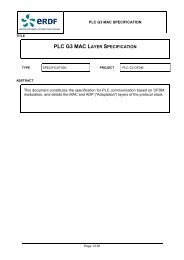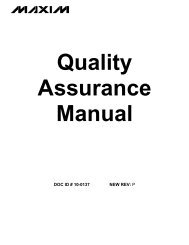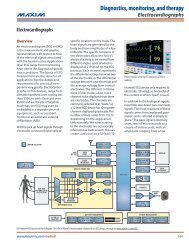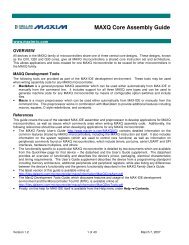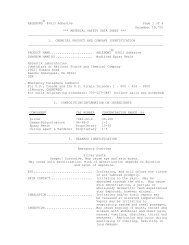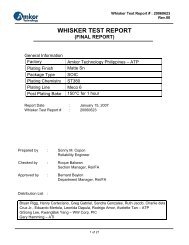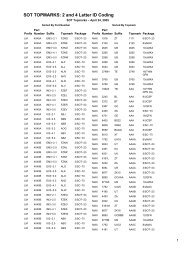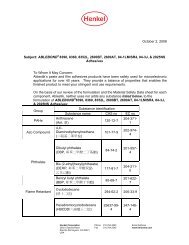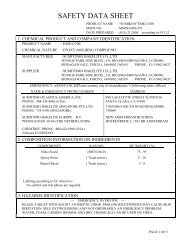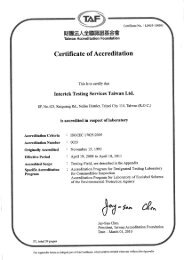Smart Grid Solutions Guide - Maxim
Smart Grid Solutions Guide - Maxim
Smart Grid Solutions Guide - Maxim
You also want an ePaper? Increase the reach of your titles
YUMPU automatically turns print PDFs into web optimized ePapers that Google loves.
CommunicationsOverviewtraffic. Protocols such as RS-485,ZigBee, Z-Wave®, and HomePlugare used for this network. If there is aseparate home gateway, it is possiblethat additional protocols could beused to communicate with appliances,thermostats, and other devices.Communications alternatives in theHAN can often coexist, but utilitysupport will probably be limited totechnologies needed to supportthe utility's primary objectives.RF communicationsWireless communications is usedin some areas for automated meterreading (AMR). Several proprietary andstandardized wireless protocols areavailable today. Frequency bands ofinterest range from 200MHz to 3.9GHz.Several blocks are used to implementRF communications (Figure 3). Thesignal is received through an antennaand goes through a bandpass filter,which rejects frequencies beyondthe one of interest. The signal is thenswitched to the receive signal chain,where one or more downconverterstranslate from the carrier frequency toan intermediate frequency (IF), thento the in-phase/quadrature-phase(I/Q) stage, and then to the baseband.More recent architectures eliminateone or more of the IF downconversionstages with a low-IF or zero-IFsampling architecture. These designsuse either a single ADC to digitizea high- or low-IF signal or, typically,two ADCs to digitize a complex I/Qbaseband signal. The ADC outputis fed into a DSP or digital ASICwhere the baseband is processed.Sometimes a microprocessor is alsoused to handle the higher layers ofthe protocol. For transmission, theprocessing path and signal chain arereversed, and the signal is sent out tothe antenna.The system can be partitioned inseveral ways. ZigBee or <strong>Maxim</strong>’sSimplelink radios, for instance, canprovide a complete system-on-chip(SoC) solution. In other cases, such asproprietary protocols, a digital ASICand an RF transceiver are used tobuild the complete radio link. <strong>Maxim</strong>has both standard RF transceiversas well as custom ASICs that can beconfigured as transceivers.Powerline communicationsOverview of modulation schemesPowerline communications usesAC power lines as the transmissionmedium. Some systems, such as<strong>Maxim</strong>’s, work over DC and cold wiresas well. There are several powerlineprotocols in the market today. Theseprotocols break down into one oftwo basic modulation schemes:frequency-shift keying (FSK) andorthogonal frequency-division multiplexing(OFDM).FSK is an older modulation schemethat has been used by the utilityindustry in the past for rudimentarypurposes, such as infrequentone-way communications frommeters to a concentrator. However,FSK suffers from a significantdrawback: if an interferer coincideswith one of the transmit frequencies,the receiver loses reception.As FSK only switches between twofrequencies, bandwidth is not usedefficiently, resulting in low data rates.This low data rate is insufficient forsmart grid applications that demandbidirectional control.Real-world PLC rollouts frequentlyrequire up to several hundredmeters to be connected to a singledata concentrator over the mediumvoltage(MV) portion of the network.This requires data communicationacross low-voltage/medium-voltage(LV/MV) transformers. Since thesetransformers can cause several tens ofdecibels of (frequency-selective) signalattenuation to FSK signals, moreadvanced and robust communicationmethods than FSK are needed.OFDM has been used in manymodern communication systemssuch as digital radio and TV, Wi-Fi,and WiMAX, as well as early-generationnarrowband protocols such asPRIME. Today, OFDM technology isenabling exciting new functions andcapabilities for PLC networks. Amongthe most significant benefits, it givesthe utility industry the bandwidthneeded to build intelligence into thepower grid while meeting aggressivecost targets.Advancements offered byG3-PLC technologyG3-PLC employs OFDM to optimizebandwidth utilization. Since OFDMuses multiple carriers to transmit data,interference at a specific frequencyor frequency-selective attenuationcan now effectively be eliminated. Inaddition to increased reliability, thiscapability allows considerably moredata to be sent.Additionally, OFDM’s spectral efficiencyallows the use of advancedchannel-coding techniques. In<strong>Maxim</strong>’s powerline solutions,advanced channel coding is usedalong with OFDM to maximizecommunication robustness inadverse channel conditions. Twolayers of error-correction coding(convolutional and Reed Solomon)are used to ensure reliable datatransmission. In addition, datais interleaved in both time andfrequency domains across OFDMcarriers to decrease the sensitivity toimpulse noise and protect againstburst errors.<strong>Maxim</strong>’s next-generation G3-PLCtechnology includes additionalcapabilities:• MAC-level security using anAES-128 cryptographic engine• Mesh routing protocol todetermine the best path betweenremote network nodes28 <strong>Maxim</strong> <strong>Smart</strong> <strong>Grid</strong> <strong>Solutions</strong>




